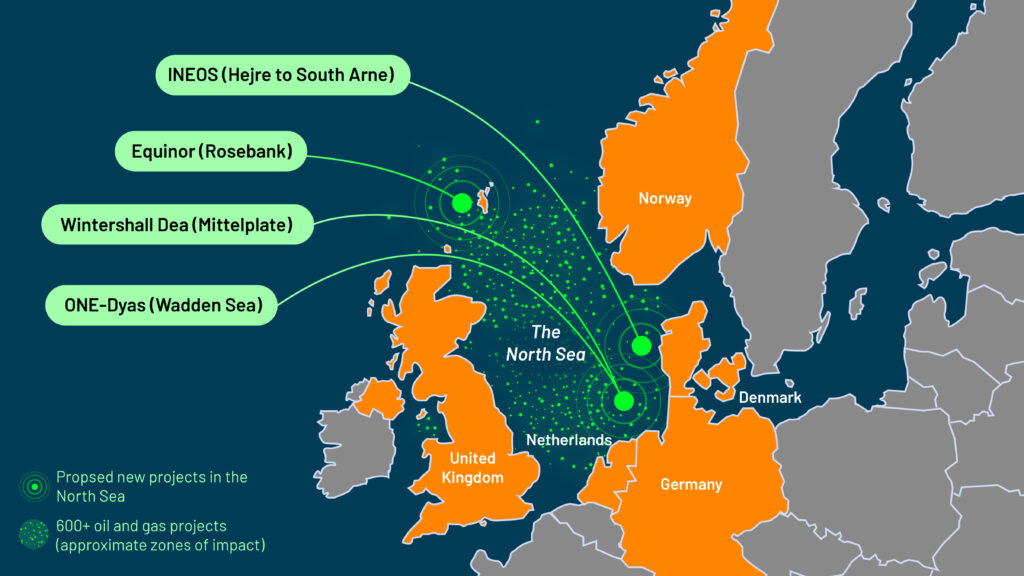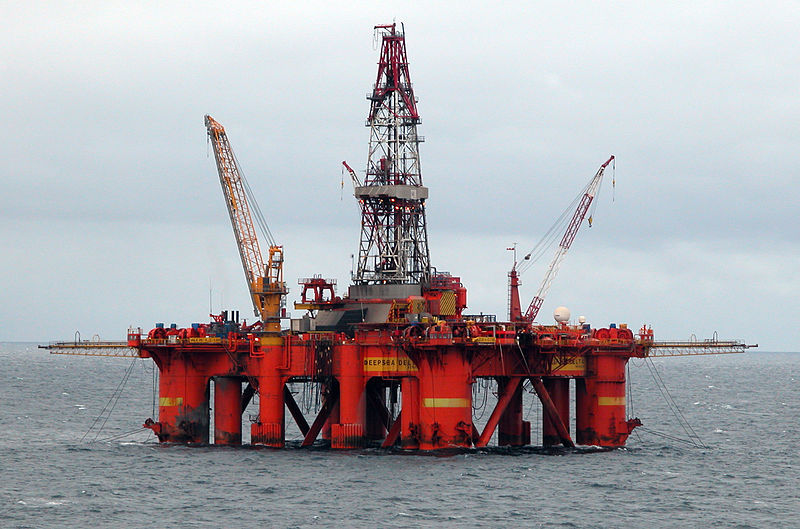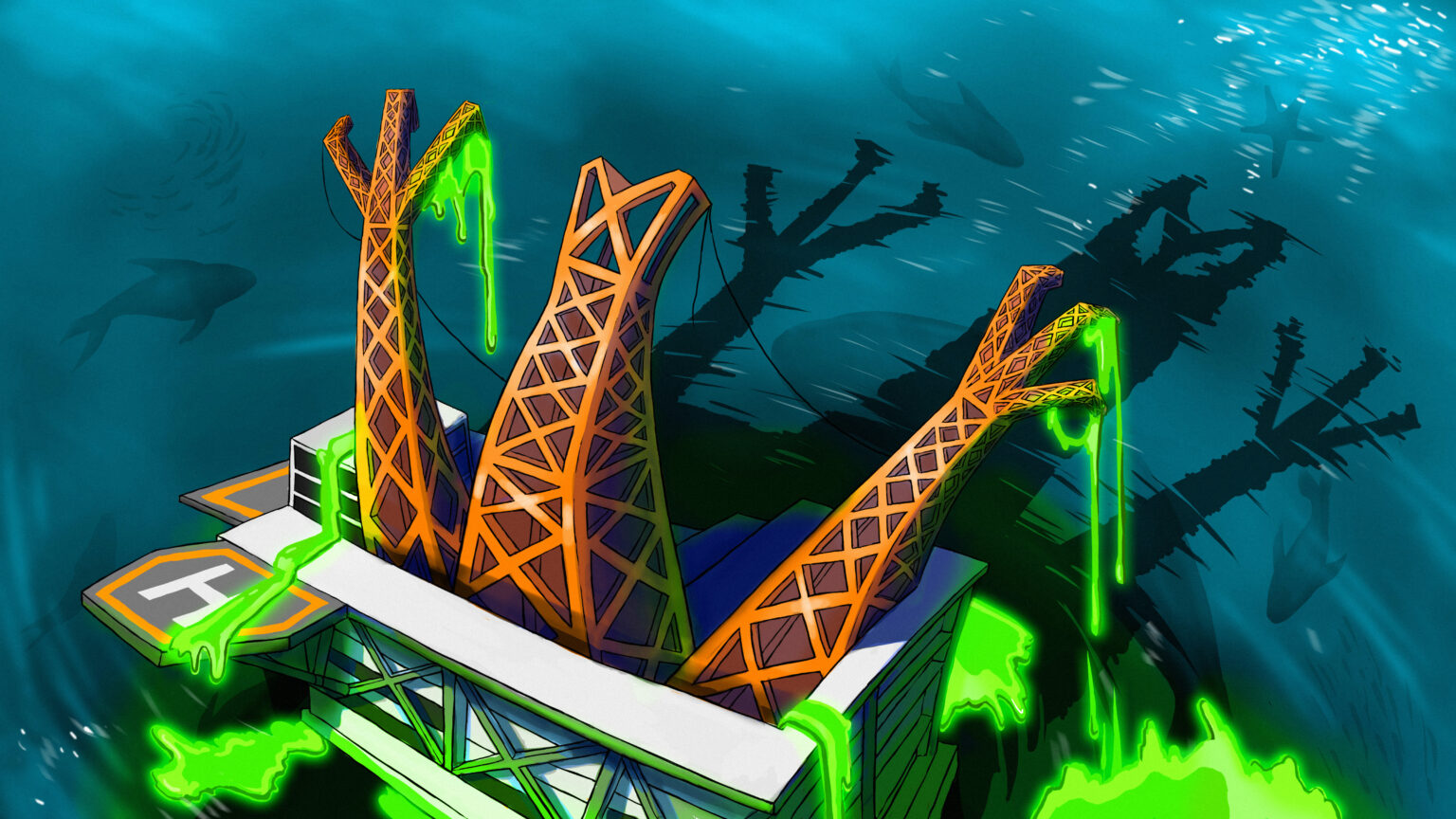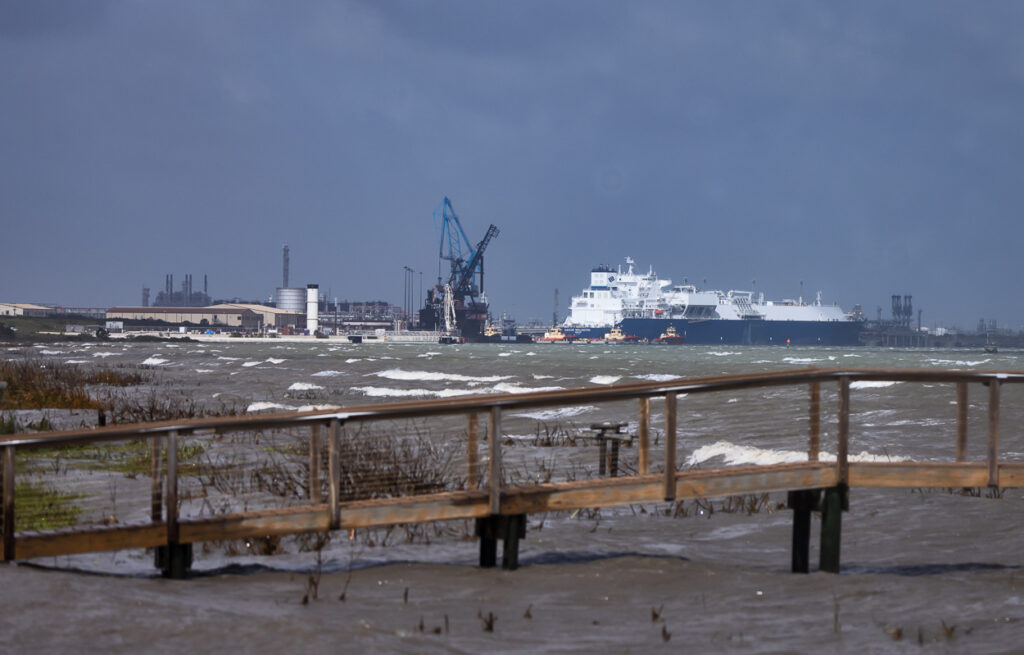This story was produced in partnership with the investigative journalism platform Follow The Money.
It was a stormy grey day in 1987 when a young environmental scientist found himself wearing a survival suit with a set of homemade sampling contraptions trailing in the ocean on an inflatable boat in the Baltic Sea. He was hunting a waste stream much of the world had never heard of: oilfield waste.
Working at that time for the environmental group Greenpeace, Marco Kaltofen was racing after a stunning realisation: that in many offshore oil and gas settings, oilfield waste is simply being dumped right into the ocean.
Fast-forward almost four decades, and an analysis by DeSmog shows that companies have been legally dumping toxic and radioactive oilfield waste into the North Sea — Europe’s arm of the North Atlantic — for decades, with largely unknown consequences for a sensitive and beloved marine environment.
Subscribe to our newsletter
Stay up to date with DeSmog news and alerts
Dating back a half-century to the earliest days of oil and gas development in the North Sea, the practice saves some of the world’s wealthiest corporations untold billions of dollars each year.
And it may get worse: Despite the accelerating climate crisis, controversial new drilling projects that will rely on free waste discharge into the ocean are still being approved.
In 2023, UK regulators gave Equinor, Norway’s state-owned oil company, a green light to drill for oil and gas in the Rosebank field northwest of the Shetland Islands.
According to the project’s 2022 Environmental Statement, drilling waste and chemicals will be discharged into the water column and onto the seabed, forming toxic piles that can “smother benthic organisms and impair their feeding and respiratory systems.”
Modern oil and gas development involves the use of many toxic and potentially toxic chemicals: biocides and scale inhibitors, meant to kill bacteria and other lifeforms that can clog a well; corrosion inhibitors, which keep oilfield pipes from corroding; and a class of chemicals known as emulsion breakers or demulsifiers, whose purpose is often to break apart mineral material and lubricate fluids to keep product flowing through the piping of an oil or gas well.
Drilling also creates a particular type of toxic waste: produced water, a naturally salty fluid laden with carcinogens, heavy metals, and naturally occurring radioactive elements, that surges to the surface during drilling. (Many wells generate more produced water than they do oil or gas).
In Danish waters, according to an in-house project summary, the Hejre to South Arne project, being developed by British chemicals conglomerate INEOS, plans to discharge “pigging waste” — production chemicals and contamination scraped from pipelines — which is acknowledged by industry experts to be dangerously radioactive. The project will also dump produced water. “The discharge may affect marine organisms, particularly pelagic organisms such as plankton including fish eggs and larvae,” the summary states.
A Stunning Amount of Waste
In 2022, the last year for which reporting is complete, oil and gas companies operating in the territorial waters of Denmark, Netherlands, Norway, and the UK have dumped 244.4 million cubic metres of produced water into the North Sea — discharged from just over 200 of the region’s 614 oil and gas installations. That’s enough to fill the Roman Colosseum 185 times over with oilfield waste, or flood the entire city of Amsterdam waist-high each year.

Produced water can contain dangerous chemicals used in drilling and production operations, as well as enough lingering crude oil to cause destructive slicks. Since 2007, when an international commission called OSPAR began keeping records, North Sea drilling sites have discharged over five billion cubic metres of produced water into the ocean. If this waste was stored in standard 160-litre (42 gallon) oil barrels, they would stack up to the moon and back nearly 36 times.
OSPAR data for 2022 indicates that roughly three times more oil was released into the North Sea from produced water discharges than from oil spills themselves. At a single oil producing region in the central North Sea east of Aberdeen, known as the Anasuria Cluster, the Anasuria Operating Company, a UK entity, discharged nearly 200 tonnes of oil in their produced water in 2022, according to OSPAR records.
“Overboard discharge from this slops tank” wasn’t properly controlled, and a substantial “mass of oil was discharged to sea non-compliantly,” read the company’s explanation.
Anasuria has not responded to DeSmog’s questions about these discharges.

OSPAR records also show that in 2022, roughly 560,000 tonnes of chemicals were used by the offshore oil and gas industry, and 181,000 tonnes were intentionally discharged into the Northeast Atlantic, with most going into the North Sea. Another 426 tonnes of those chemicals were accidentally spilled into the ocean. That means that about one-third of the chemicals used by the offshore oil and gas industry ended up in the ocean.
These chemicals included biocides, as well as corrosion inhibitors and demulsifiers with properties so toxic they can kill most algae, crustaceans, and fish they come in contact with. The industry also dumped dozens of tonnes of plastics and microplastics in 2022.
This practice is global, and research from around the world suggests that it is having dramatic environmental consequences. In the United States, campaigners say oilfield dumping is helping to push an endangered population of beluga whales in Alaska’s Cook Inlet to extinction. As far back as at least 1990, research has documented the accumulation of radioactive elements from oilfield waste accumulating in Gulf of Mexico oysters. A 2005 U.S. government study linked oilfield waste to a gigantic low-oxygen patch in the Gulf known as the Dead Zone.
More recently, research published in 2013 by the Norwegian Institute for Water Research found that oilfield waste discharges are “a continuous source of contaminants to continental shelf ecosystems.” Other studies out of Norway have found produced water contaminates mussels near offshore installations, can induce cardiac defects in salmon fry, negatively affect haddock eggs, and cause DNA damage in certain fish species.
“Big spills grab the headlines, but what people often don’t realise is a toxic drip feed of oil and chemicals from the fossil fuel industry is polluting our ocean with frightening frequency,” says Naomi Tilley, the oil and gas campaign lead with Oceana UK, a nonprofit ocean advocacy group.
“For five decades, UK oil and gas production in the North Sea has taken place largely out of sight and, therefore, out of mind,” with “little thought…given to the impact of drilling thousands of wells and developing hundreds of oil and gas fields on the UK’s marine environment,” reads the group’s 2023 report, “In Deep Water: Exposing the Hidden Impacts of Oil and Gas on the UK’s Seas.”
Environmental groups contacted for comment were appalled by DeSmog’s findings. “Disposing of this waste safely, rather than just dumping it in our oceans, should be prioritized,” says Rosemary Harris, UK North Sea Senior Campaigner with Oil Change International, an international advocacy group. “These companies use dangerous shortcuts to maximise their profit margin, at our planet’s expense.”
Produced water can contain elevated levels of the radioactive element radium, a human carcinogen that accumulates in bones. OSPAR has tracked marine discharges of radioactive waste by the nuclear industry since the 1980s, including discharges from power stations, fuel reprocessing plants, fuel fabrication and enrichment plants, research and development facilities, and decommissioning facilities.
Yet releases of radioactive materials into the North Sea by the oil and gas industry, “are forty times those reported by the nuclear energy sector,”according to a 2016 report from the International Association of Oil & Gas Producers, an imbalance that persists in more recent datasets.
In the U.S., environmental groups large and small have devoted considerable attention to oilfield waste and associated contamination threats posed to public health, the environment, and the industry’s own workers.
“The industry just has too much waste, and they are producing more and more,” says Ted Auch, who has spent over a decade investigating oilfield waste contamination as an analyst with the watchdog FracTracker Alliance. “That is entirely due to the fact that they are allowed to dispose of their waste in an ad hoc and extremely cheap manner by methods that have been known to be dubious for decades.”
Auch’s is part of a growing chorus of voices who believe that oilfield waste, rather than climate change, will be the way to most effectively hold oil and gas financially liable for its environmental harms.
“At the end of the day waste is what’s going to move the needle,” says Auch. “This is their Achilles’ heel.”
Dumping Nearly Invisible to the Public
North Sea oilfield waste discharges have not made headlines across Europe, even though many Europeans eat fish and shellfish from the North Sea, vacation on its beaches, and generally regard the sea as a regional treasure.
Even many European activists, while aware that the oil and gas industry produces emissions that harm the climate, tend to think they live in a part of the world with robust environmental regulations, especially when it comes to marine environments.
Some people outright deny that such blatant contamination is possible, saying that the North Sea offshore oil and gas industry is averse to contaminating the ocean because even an incident as trivial as a worker dropping a wrench overboard would result in laborious paperwork.
“I think in the Netherlands polluting the North Sea would be very difficult,” says Sybe Visser, a Dutch driller who has spent 40 years working in the North Sea, “because everything is checked, and especially waste is checked, there is always a manifest — we make sure nothing would fall overboard.”
The problem is compounded by regulators’ reliance on the oil and gas industry to take their own samples and submit reports.
“It is incredibly difficult to know with any certainty the accuracy of the data given there is no independent verification,” says Oceana UK’s Tilley, who believes it’s reasonable to assume that the total discharges reported to OSPAR are underestimates.
Regulators in northern Europe have consistently downplayed the ramifications of dumping excessive amounts of oilfield waste. The tendency is to believe that the North Sea is large enough, and the radioactivity and other contaminants in oilfield waste are of sufficiently minute quantities, that the diluting effect of the ocean will spare ecosystems from harm.
“With respect to overboard water my impression is radioactivity is well under control and the situation is okay,” said Yuri Franken, the lead regulator on radioactive materials license applications for the Dutch Authority for Nuclear Safety and Radiation Protection.
Experts with experience tracking contaminants through aquatic environments disagree. “This is not how nature works,” says Kaltofen, the seawater-sampling environmental scientist, who went on from his Greenpeace days to become a nuclear forensics expert. Today, he has more than 30 years of experience sampling oil spills and chemical releases around the world, and is now warning of the potentially destructive effect of toxic and radioactive oilfield waste in the ocean.
“For every dispersive process in nature, there is a corresponding concentrating process,” says Kaltofen. “The first millimetre of ocean is a robust layer filled with life and where all that lifegiving chemistry happens, that millimetre is richer than the seven miles of ocean beneath it combined, and that is exactly where many contaminants will concentrate.” Meanwhile, denser contaminants fall to and concentrate on the seafloor, another critically important slice of the marine ecosystem.
The UK Department for Energy Security and Net Zero, the country’s environmental regulator for the offshore oil and gas industry, has not replied to DeSmog’s questions regarding oilfield waste discharges.
The Danish Energy Agency, responsible for regulating oil and gas activities in the Danish North Sea, says the agency “issues discharge permits in accordance with the current regulations of the area” and follows OSPAR’s recommendations that aim to “move towards the target of cessation of discharges of hazardous substances.”
In Norway, where there has been a distinct effort by regulators and researchers to investigate potential harms caused by oil and gas industry waste discharges, regulators express more concern.
“Operational emissions from petroleum activities in the North Sea are significant and contribute to increases in background levels of oil and other environmentally hazardous substances and naturally occurring substances over time,” says Ann Mari Vik Green with the Norway Environment Agency.
In addition to produced water, operators in the UK and Norway dump at least 10,000 tonnes of drilling waste each year directly onto the ocean floor. This waste stream is composed of drilling muds (also known as drilling fluids), which are used to lubricate drill bits and structurally support the drilling borehole, as well as drill cuttings: the crushed rock and dirt removed in the drilling process.
While OSPAR imposed regulations in 2000 that significantly reduced the types of hazardous substances allowed in drilling fluids and muds, drilling waste can still be laden, legally, with hydrocarbons and heavy metals like arsenic, chromium, lead, and mercury. These highly toxic substances can harm plankton and filter-feeding mollusks and shellfish. This discharged drilling waste forms a ghostly network of toxic pyramids on the seafloor, continuously shifting and crumbling with the currents.
Organisms “can accumulate chemical contaminants in their tissues,” reads a 2019 OSPAR report on drilling waste. The deposition of drilling waste can create local toxic zones that pose threats even years and decades later when disturbed by other activities, such as deep sea fishing, re-releasing heavy metals into the marine environment.
A 2012 report from the Research Council of Norway, on long-term effects of discharges to sea from petroleum-related activities, states, “Experiments have shown that the cuttings that are discharged today are cleaner, but that they nonetheless can have serious effects on exposed organisms.”
OSPAR data shows that in 2022, the Norwegian oil and gas industry discharged 116 million cubic metres of produced water into the ocean, deposited 4,920 tonnes of drilling waste on the seafloor, and put 119,600 tonnes of chemicals overboard.
Why Drilling Waste Discharges Remain Legal
In the North Sea, a series of international regulations explicitly ban the discharge of many contaminants into this unique marine environment. They include the Merchant Shipping Regulations of 1996; the Offshore Chemicals Regulations of 2002; the Offshore Petroleum Activities Regulations of 2005; and the International Maritime Organization’s Convention on the Prevention of Marine Pollution by Dumping of Wastes and other Matter, better known as the London Convention of 1972.
But the rules apparently include significant exemptions for oil and gas. Vik Green with Norway’s Environment Agency provided further clarification. “In the London Convention and the OSPAR convention,” she says, “discharges coming from the drilling and production of hydrocarbon is not defined as dumping and not prohibited.”
In 2000, OSPAR adopted a system to reduce the overall impact of offshore chemicals on the marine environment by promoting “the shift towards the use of less hazardous or preferably non-hazardous substances,” says OSPAR Communications Lead Lucy Ritchie. But OSPAR’s most recent records of discharges, from 2022, cast doubt on how well the oil and gas industry has complied with this target. (OSPAR has a two-year reporting process, so 2023 data will be published by September 2025.)
In Norway, the Pollution Control Act of 1982 has “a general prohibition of pollution,” Vik Green explains, although polluting industries may apply for a permit enabling them to pollute the sea. “We must weigh the environmental disadvantages and the socioeconomic advantages of any industrial project,” she says, “and if a permit is granted the pollution is not illegal.”
OSPAR records show that among the nations operating in the North Sea in 2022, Norway discharged the most chemicals to the sea by far at nearly 120,000 tonnes — the weight of 24,000 African elephants. That was followed by the UK at 48,000 tonnes, and the Netherlands at just over 8,000 tonnes, all values that represent increases from 2021.
Notably, Germany had no chemical discharges, since it adheres to a policy of no discharges to the marine environment. Instead, Germany relies on injecting produced water back into the oil and gas-bearing formation.
In the U.S., underground injection wells have been linked to damaging earthquakes in Oklahoma. Injection well leaks and subsequent contamination have been documented in Texas and Ohio.
Such leaks have also posed problems in the Netherlands and Germany. Björn Völlmar, a spokesperson with the Lower Saxony and Schleswig-Holstein State Authority for Mining, Energy and Geology, says the practice is permissible under German regulations, and that the agency “is not aware of earthquakes, leaks and/or contaminants.”
The production chemicals being discharged, according to OSPAR’s 2019 report, include substances that can disrupt the endocrine systems of aquatic organisms, which involve important hormone and reproductive functions. Others are possible carcinogens, damage DNA, and are “toxic to embryos.” Many of these chemicals are so toxic that just 1 milligram in a litre of water would kill half the algae, fish, and crustaceans exposed.
OSPAR records for 2022 show the Norwegian oil and gas production company Vår Energi discharged biocides. The Norwegian company Aker BP discharged biocides and corrosion inhibitors. In Danish waters, a set of oil installations operated by the multinational French firm TotalEnergies discharged biocides, corrosion control chemicals, and the surfactant octylphenol, a chemical that, according to one academic handbook on endocrinology, disrupts “estrogenic activity, and thus [is] considered to be a risk, particularly for freshwater and marine aquatic animals.”
In response to questions on the health and environmental impacts of these discharges, a TotalEnergies spokesperson cited the company’s Universal Registration Document 2023, which says that it discharged 68.4 billion litres of oilfield wastewater into the sea that year — the equivalent of 2.3 trillion shots of espresso.
OSPAR records indicate that in 2021, and again in 2022, Dana Petroleum Netherlands discharged a corrosion inhibitor called Cortron RN-629 at an oil installation it operates in shallow waters. A subsidiary of the Korea National Oil Corporation, Dana Petroleum operates oil and gas installations in the UK, Netherlands, and Egypt. Cortron RN-629 could not be found on a comprehensive list of industrial chemicals, but chemical guides called “safety data sheets” indicate similar corrosion inhibitors made by the same company are highly flammable and toxic on contact — they can damage organs, cause severe skin burns, and be fatal if inhaled.
In 2022, Equinor discharged an unnamed corrosion inhibitor and the possible human carcinogen naphthalene into the North Sea.
In an odd twist of law that demonstrates the failings of the current regulatory system, the oil and gas industry’s 181,000 tonnes of chemicals deliberately discharged into the North Sea in 2022 are entirely legal, while its 426 tonnes of accidentally spilled chemicals are illegal.
BP, INEOS, Equinor, ONE-Dyas, Dana Petroleum Netherlands, and Vår Energi did not respond to questions regarding their oilfield waste discharges into the North Sea.
“It shows this topic is hidden,” says Clara Winkler, an analyst with Environmental Action Germany. “Most of the real knowledge on this is owned by the fossil fuel industry and they will not share it with us.”
Justin Nobel’s first book, PETROLEUM-238: Big Oil’s Dangerous Secret and the Grassroots Fight to Stop It, tells the story of his seven-year investigation into how the U.S. oil and gas industry has avoided environmental regulations and created a dangerous and radioactive public health crisis.
Subscribe to our newsletter
Stay up to date with DeSmog news and alerts






